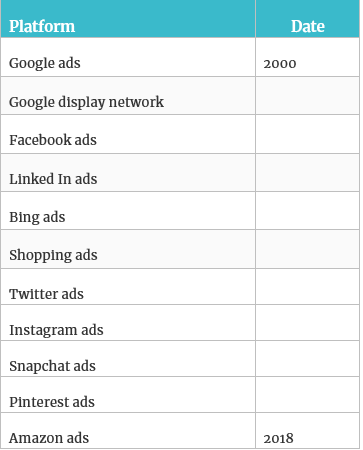Over the last 18 years or so, there’s been considerable growth in digital advertising. With social media constantly expanding, Google and Bing continuously updating their proposition and Amazon stepping into the game, paid media is, unsurprisingly, described as a fast-growing industry.

So, how can digital marketers keep up with it? And how can they overcome the challenge of needing to be an expert in specific platforms while also maintaining a good breadth of general digital knowledge (both of which are needed to drive continued brand growth)?
Use knowledge from one channel and apply relevant insights to other channels
There are many differences between digital platforms, however, they generally follow similar logic across the board. At a very basic level, if someone clicks on an ad, it’s likely they have an interest in the messaging being promoted by the brand.
This key is to be considered from a more technical and performance-driven point of view as well; keyword insights from Google and Bing can be used as a starting point for setting up search ads on Amazon, while creative learnings from paid social can be used to plan ads to test in display campaigns, and vice versa.
Big picture thinking: The value of understanding the different functions of each platform
While understanding similarities can strengthen the strategy for new channels, it’s also important to understand how they differ, and how the shared learnings should be balanced with separate channel-specific testing. This will help ensure that campaigns are being optimised for how customers typically use the platform.
One method often applied when thinking about the various functions of platforms is the conversion funnel. This takes many forms, but the core idea is to match up the ad served to where a potential customer is in their journey to purchase, whether that be brand awareness or consideration or action phase. Typically, display and paid social campaigns lean more towards the start and middle of the funnel, whereas paid search sits towards the end of it. However, this varies depending on the strategy and targeting being implemented. As a result, the key performance indicators will differ between different channels, and identifying the primary and secondary metrics at each stage will be useful to measure the success of activity.
Make sure channels are working together
When planning a digital strategy across different platforms, it can be a challenge to understand the optimal customer journeys between them all. Using precise audience targeting to serve the top converting ad journeys can help improve performance; for example, targeting previous purchasers through display with banners to upsell related products, or sharing audiences between YouTube and Google ads.
Building themes within creative and messaging will then ensure the customer is able to make a clear brand link across a range of media sources. When it comes to paid social and display channels, imagery can contain common features based on what performs best on each platform. ‘IF’ functions can be used in paid search to serve adapted ad copy to audiences at different stages of their purchase journey, reflecting a similar tone to the more visual channels.
Once the campaigns are up and running, working on attribution modelling is important as it enables brands to understand what’s working and what isn’t, which platforms are crucial to driving conversions, and which aren’t. Attribution is an ongoing process, and often several models, from first and last click to data-driven, need to be considered to get a clearer picture.
Keep the consumer front of mind
When planning across multiple channels, it’s easy to lose track of who you’re looking to reach. Therefore, a combination of media owner insights and customer profiling, as well as learnings from any historic activity, can be gathered to identify the optimum audiences to target.
The media platforms have a wide range of data across a variety of industries and keyword sets. Working closely with media owners such as Google, Facebook, and Pinterest is key to identifying relevant, valuable audiences and to scope out new customer acquisition opportunities.
First-party brand insights, such as demographics, customer trends, and product preferences, are a solid starting point when agreeing who to target as well. If existing data is limited, data management platform (DMP) tags can be implemented to match up people visiting and converting on-site with different interest segments and profiles. These interest segments can then be used to identify potential interest audiences on Twitter and Instagram, for example.
Stay up-to-date with new features
Keeping on top of recent blogs is a great way to find out what others are doing in your industry. This can prompt ideas for similar methods to test or how to optimise an existing strategy.
Similarly, information from media owners, such as Google and Snapchat, is useful for finding out about recommended new features and how to apply them, or which new betas can be tested. With new developments being launched across the platforms on a regular basis, getting whitelisted for new betas is valuable so you can assess what works and what doesn’t, and what learnings to take as next steps from the testing.
Work with teams who have the option of specialising or broadening their interests
No matter how many blogs you read, it’s impossible for one person to know everything, so working with people who have varying strengths is extremely beneficial. Depending on people’s interests, either encourage team members to gain more knowledge in their preferred areas, or support them in their bid to find out about new advancements in the industry (or both!). These approaches will help broaden the expertise of the team as a whole, and people’s experiences can be shared with one another to build on knowledge of new advertising platforms.
Both improving existing advertising activity and identifying new opportunities have always been key to driving performance for brands and media partners. Finding the balance between the two can be challenging, so ensuring the team has the opportunity to be involved with both can boost their contribution and maximise the growth of accounts.


